Abstract
In this study, a technical index system for nuclear accident emergency response measures was established and comprehensively evaluated by studying the impact of time, ventilation speed, and leakage speed on the radiation consequences after a loss of coolant accident (LOCA) in a marine reactor. The weight of each index was calculated by the analytic hierarchy process (AHP), and the weight of the radiation protection measure in the second-level index emergency measure was 0.625, accounting for the maximum proportion. The weights of improving radionuclide detection technology in chambers, improving detection capability, and improving the diagnosis efficiency of radiation damage in the three-level indicator emergency measures were 0.4442, 0.4384, and 0.4521, respectively, accounting for the maximum proportions. The fuzzy comprehensive evaluation method was used to quantify and comprehensively evaluate the index system of emergency measures. The quantitative evaluation result was 82.8 points, indicating that the evaluation result was adequate. Therefore, the nuclear emergency response measure based on the radiation consequences of a marine reactor LOCA is reasonable and feasible. It provides valuable measures and practical guidance for the emergency response of a marine reactor LOCA, and dramatically reduces the harm of radiation to staff and the environment.
1. Introduction
1.1. Literature Review
Domestic and foreign scholars have actively conducted studies on the safety technology of advanced energy [1], particularly for marine nuclear energy and nuclear accidents. Safety technology guarantees the application and development of nuclear power devices. Reactor cores can melt under severe accident conditions, releasing large amounts of radioactive materials that can further spread into the cabin and the environment. Marine nuclear reactors lose power, contaminating the cabin and surrounding environment and affecting the safety of operators, the public, and the environment. Therefore, the marine reactor’s nuclear emergency response measure is an essential component of marine reactor safety. Reasonable and practical nuclear emergency response measures can guarantee workers’ safety. Implementing emergency response measures can reduce the release of radioactive substances, harmful effects on workers, and the economic loss of instruments and equipment [2]. According to statistics, there have been more than 300 severe global marine reactor accidents, with the proportion of loss of coolant accident (LOCA) being the highest, accounting for approximately one-third of all accidents [3]. It is particularly important to study emergency response measures in the event of a LOCA in a marine reactor.
Complex accident environments have higher requirements for emergency technology [4]. The marine reactor used in this study was a pressurized water reactor (PWR) with 330 MW of thermal power. The marine reactor was located in an offshore, mobile nuclear power platform with an organic combination of a small nuclear reactor and marine engineering. The water make-up system of the marine nuclear reactor comprised a deaerator, control valve, make-up water pump, heat exchanger, upper distillation tank, filter, ion exchanger, and upper charging pump. The marine reactor was divided into various sections: nuclear reactor area, control room, steam turbine power generation area, nuclear fuel storage area, residential area, and helicopter area.
In terms of the accident-related consequences of marine nuclear reactors, Xue Feng et al. [5] studied the release process of hydrogen in a marine nuclear reactor LOCA, and simulated its two-dimensional flow field and diffusion distribution in the reactor cabin. Given the risk of a hydrogen explosion after a LOCA, they proposed a hydrogen control system that eliminates hydrogen in the cabin and improves the safety performance of the marine reactor. Ouyang et al. [6] established a particle tracking model for the atmospheric diffusion of radionuclides over the sea, and analyzed the effects of seawater absorption at different heights. A reasonable seawater absorption height reduces the diffusion of radionuclides in the atmosphere. Our previous study established an accident analysis model for a LOCA caused by a small break in a marine reactor [7]. We also studied the release regularity of gaseous radionuclides based on severe accident analysis programs [8]. In addition, the radionuclide release rules under loss of coolant accidents (LOCAs) with large, medium, and small breaks were compared and analyzed, and a sensitivity analysis was carried out [9]. A research method for coupling hydrodynamics models in severe accident analysis programs was proposed to analyze and discuss the diffusion regularity of radioactive substances in closed cabins after a marine reactor LOCA [10]. A dynamic fault tree model of a marine reactor LOCA was established to analyze the system reliability and understand the weak links of the mechanical system [11]. In this paper, we analyze the radiation consequences of a marine reactor LOCA, and provide data support and theoretical reference for emergency measures. Pronob et al. calculated and analyzed a LOCA caused by the arbitrary rupture of a cold leg section in a III+ VVER-1200 reactor. The influence of an emergency core cooling system (ECCS) with or without a LOCA was compared and analyzed [12]. Zubair et al. used Flowex software to study the behavior of a core emergency cooling system after the LOCA of a PWR [13]. They conducted uncertainty and sensitivity analyses on the safety injection system at different break sizes and compared and analyzed the mitigation strategies for LOCA. Relevant parameters for safe injection systems play an essential role in alleviating water loss accidents. Regarding emergency response measure research, it is necessary to establish emergency indicators and determine their weights. Three commonly used weighting methods are participatory weighting with public or expert opinions, equal weighting, and statistical weighting [14,15]. Learning from the impact of the Fukushima Daiichi nuclear power plant accident is important in establishing a reasonable nuclear accident emergency management strategy for the operation of nuclear facilities [16]. In the context of accident management evaluation research, the South Korea Nuclear Power Station proposed accident emergency strategies for extended station black-out (SBO) accidents and evaluated their effectiveness. The established emergency strategies have been effective for extended SBO [17]. The fuzzy comprehensive evaluation method has significant advantages associated with the comprehensive evaluation of measures. Recently, scholars have used the analytic hierarchy process (AHP)/fuzzy comprehensive evaluation method combined with other analytical methods to analyze decision-making schemes [18]. Risk assessment and management technology through fuzzy comprehensive evaluation methods have been applied in various fields [19]. The hazards of radionuclides after a severe accident in a marine reactor are emphasized in the aforementioned literature, reflecting the importance and necessity of research on the consequences of radiation. Some scholars have designed specific measures to improve the safety performance of marine reactors from the management perspective for specific nuclear accidents or have formulated accident emergency strategies in advance to reduce accident hazards. In this paper, based on the conclusions of the radiation consequences of accidents, emergency response measures for nuclear accidents are established to provide valuable strategies and practical guidance for the emergency response of a marine reactor LOCA.
In our previous studies, we applied MELCOR, a severe accident analysis program, to study the release behavior of radionuclides in a marine reactor LOCA. We investigated the diffusion of radionuclides in a closed cabin using fluid dynamics. This study applied the same structural model but with a different structural division and used the same research means but different data results. Therefore, this study focused on various emergency response measures based on the radiation consequences of marine reactor LOCA. Based on our previous study, we further investigated the effects of radiation dose rates in different compartments on workers and the consequences of different ventilation speeds. We developed emergency decision making targeted at marine reactor LOCA and evaluated the rationality and applicability of these emergency response measures.
Based on a marine reactor’s established accident consequence analysis model, this study determined the influence of time, ventilation speed, and leakage speed on radiation consequences after LOCA. An index system for the emergency response measure of a marine reactor LOCA was established according to the radiation consequences. The analytic hierarchy process was used to determine the weight of each index of emergency response measures. The fuzzy comprehensive evaluation method was used to evaluate emergency response measures because it provides valuable strategies and practical guidance for the emergency response of the marine reactor LOCA, and dramatically reduces the harm of radiation to workers and the environment.
1.2. Research Significance
Marine reactor LOCAs release many radionuclides, which cause radiation damage to staff and severe pollution to the environment. The radionuclides’ dose level in the marine reactor cabin exceeded the maximum dose limit, and the radiation consequences were severe. Therefore, the radiation consequences of the marine reactor LOCA were studied according to the numerical simulation method, and the targeted emergency response measures were designed based on their impact. Research on the consequence assessment of severe accidents in marine reactors can help predict and evaluate nuclear accidents, improve technical support for emergency responses, and reduce hazards.
2. Methods
2.1. Consequence Analysis Model for a Marine Reactor LOCA
It is necessary to consider radionuclide generation, release, diffusion, and radiation consequences caused by LOCAs in marine reactors. Therefore, the consequence analysis model for a marine reactor LOCA mainly consists of three parts: the structural model for the marine reactor compartment, the source term release model of the LOCA, and the radiation dose calculation model. The simplified structural model of the marine nuclear compartment [20] mainly contains the chamber adjacent to the reactor, equipment chamber, and staff chamber, as shown in Figure 1.

Figure 1.
Simplified model diagram of the marine reactor’s chamber distribution.
2.2. Calculation Model of Radionuclide Release
Mitigation measures were not implemented in time for a large break LOCA in the marine reactor or the initial event, which led to a core melting accident. After the LOCA, the reactor was shut down due to the containment rupture. Then, the core was completely exposed, the core support plate failed, the lower head failed, and the containment pressure vessel broke. Due to the core melting and slag migration, many radionuclides leaked out, and the radioactive fission products in the reactor entered the containment from the pressure vessel and adjacent area through the containment notch. The source term release model for the marine reactor LOCA helped simulate the radioactive fission products released during the accident. In this study, we used the severe accident analysis program MELCOR to calculate the release of radionuclides. The release rate of radionuclides is expressed exponentially in [7].
where stands for the release rate, and the unit is quota/min. A and B represent empirical parameters. T represents the reactor core temperature, where the unit is K. is the minimum temperature at which release begins, and the value is = 1173 K, which is the threshold temperature of radionuclide core release.
2.3. Accident Assumption and Process Analysis
A large break LOCA occurred in the marine reactor due to a double-end fracture in the cold pipe section, which failed the pressure boundary of the reactor coolant system. The coolant flowed out of the reactor coolant system without control. The water level in the reactor coolant system decreased, and the pressure of the pressurizer and water level decreased. The decreased coolant flow through the core led to partial vaporization, which reduced the core heat transfer and caused core burnout. The radionuclides that leaked from the core migrated into the reactor pressure vessel. Of course, a safety injection system is present to overcome the LOCA. After an accident, the safety injection system injects emergency water into the reactor coolant system to maintain its water inventory or ensure that the core is flooded to prevent a core meltdown.
The release fraction of radionuclides and temperature change with time obtained using the source term release model of a marine reactor LOCA are the initial conditions for studying and analyzing radionuclide diffusion in closed environments. The number of radionuclides diffused at various times after a severe accident was calculated by establishing the diffusion and migration model in the source term of the LOCA. We considered the radiation consequences on the staff in the cabin due to radionuclide diffusion. We considered three major exposure pathways caused by the radioactive release for dose estimation: external exposure to smoke cloud immersion, internal exposure to inhalation, and external exposure to ground deposition. The external and internal exposures to four main radionuclides 131I, 137Cs, 85Kr, and 133Xe released from the marine reactor LOCA were obtained by calculating the dose conversion factor.
3. Impact Analysis of Radiation Consequences
According to the International Commission on Radiological Protection (publication 60), the effective dose for emergency personnel should not exceed approximately 500 mSv, except for life-saving operations. Assuming that emergency personnel respond within 30 min of the accident, the maximum allowable dose rate for staff is 1000 mSv/h. Four representative radionuclides, 131I, 137Cs, 85Kr, and 133Xe, were selected for this study, and their total radiation dose rates were calculated considering the radiation effects at the total radiation dose rates. Figure 2 shows the radiation dose rates over time in each cabin under various ventilation speeds, which were calculated using the consequence analysis model of a marine reactor LOCA [10]. As shown in Figure 2, in the first 60 s after the LOCA, the radiation dose rate in each compartment increased slightly, and then rapidly over time. It exceeded the maximum allowable dose rate workers could tolerate for a short time.
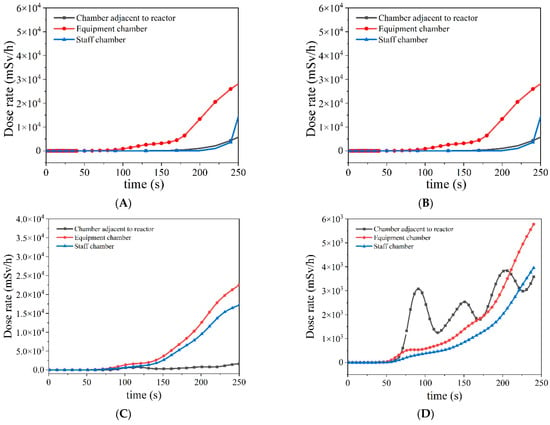
Figure 2.
Variation curve of radiation dose rate with radionuclide accumulation under different ventilation speeds. (A) 3 m/s; (B) 5 m/s; (C) 9 m/s; (D) 11 m/s.
As shown in Figure 2, when the ventilation speed was 3 m/s, the radiation dose rates in the chamber adjacent to the reactor, equipment chamber, and staff chamber exceeded the dose rate limit after 197, 103, and 220 s, respectively. When the ventilation speed was 5 m/s, the radiation dose rates in these three chambers exceeded the dose rate limit after 132, 83, and 165 s, respectively. When the ventilation speed was 9 m/s, the radiation dose rates in these three chambers exceeded the dose rate limit after 228, 93, and 116 s, respectively. The radiation dose rate variation in the chamber adjacent to the reactor with the radionuclide accumulation was substantially different from those in the equipment and staff chambers due to the increase in ventilation speed, which led to different radionuclide diffusion paths in the chamber adjacent to the reactor. Thus, it took a long time for the radiation dose rate to exceed the dose rate limit. When the ventilation speed was 11 m/s, the radionuclide diffusion path changed further with the continuous increase in ventilation speed. The time it took to exceed the dose rate limit in the chamber adjacent to the reactor was shorter than at 9 m/s ventilation speed. At this ventilation speed, the radiation dose rates in the chamber adjacent to the reactor, equipment chamber, and staff chamber exceeded the dose rate limit after 74, 135, and 159 s, respectively.
Under different ventilation speeds, the distribution of radionuclides accumulating radiation dose rates exceeding the limit value in different areas is not a linear trend. When the ventilation speeds were 5 and 11 m/s, the safe evacuation times for the chamber adjacent to the reactor were 132 and 74 s, respectively, shorter than those at other ventilation speeds because the chamber adjacent to the reactor was closest to the containment. When the ventilation speed was low, the radionuclides were mainly diffused through gravity sedimentation. When the ventilation speed was increased, the radionuclides encountered the wall with acute airflow diffusion in the chamber adjacent to the reactor, thereby forming vortices. The longer they stayed in the chamber adjacent to the reactor, the shorter the evacuation time.
Figure 3 shows the evacuation times in the chamber adjacent to the reactor, equipment chamber, and staff chamber under different ventilation speeds. When the ventilation speed was low, the more time the radiation dose rate accumulated in different areas and exceeded the dose rate limit. The longest evacuation time in the chamber adjacent to the reactor was 228 s at a ventilation speed of 9 m/s, whereas the shortest evacuation time was 74 s at a ventilation speed of 11 m/s. Therefore, if staff are in the chamber adjacent to the reactor when a marine reactor LOCA occurs, the best emergency response measure would be to set the ventilation speed within the range of 7 to 9 m/s to provide sufficient time for safe evacuation. The longest evacuation time in the equipment chamber was 135 s at a ventilation speed of 11 m/s, whereas the shortest evacuation time was 80 s at a ventilation speed of 7 m/s. Hence, if personnel are in the equipment chamber when a marine reactor LOCA occurs, a ventilation speed of 11 m/s would be the best emergency response measure. The longest evacuation time in the staff chamber was 220 s at a ventilation speed of 3 m/s, whereas the shortest evacuation time was 84 s at a ventilation speed of 7 m/s. Therefore, if workers are in the staff chamber when the marine reactor LOCA occurs, the best emergency response measure would be to set the ventilation speed in the range of 3 to 5 m/s to provide sufficient time to evacuate safely.
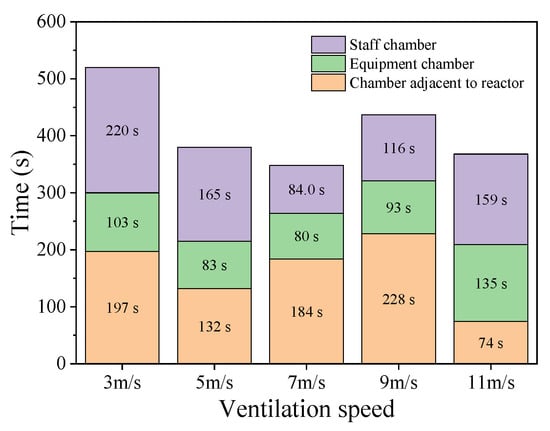
Figure 3.
Evacuation time at different ventilation speeds.
4. Nuclear Accident Emergency Measure for a Marine Reactor
4.1. Selection and Determination of Emergency Measure Indexes
Other nuclear accident emergency measures are based on expert judgment and quantitative results, whereas the emergency measures specified in this study were based on experimental results. Based on the radiation dose consequences caused by the diffusion of radionuclides in closed cabins, special targeted emergency measures for severe accidents in marine reactors were formulated considering the injury to workers. These emergency measures provide reference data for expert judgment and analysis. Based on the consequence analysis model for the marine reactor LOCA, it is necessary to conduct safety evaluation research on the marine reactor LOCA from three aspects: the release of the source term, diffusion of radionuclides in closed environments, and radiation dose. Thus, indices for emergency response measures are mainly determined by monitoring the source term release, monitoring the diffusion of radionuclides in closed environments, and radiation protection measures.
In a previous study, many radionuclides were released from the core after a LOCA occurred in the primary circuit of the marine reactor. Most of the radionuclides were concentrated in the cabin area. Thus, monitoring of the source term [21] released was regarded as a secondary index of emergency response measures for the marine reactor LOCA. The variation trend in the amounts of alkaline earth released in the primary circuit during the accident is shown in Figure 4. The radiation dose rate increased rapidly due to the accumulation of radionuclides in different areas, thereby increasing the radiation hazard to workers.
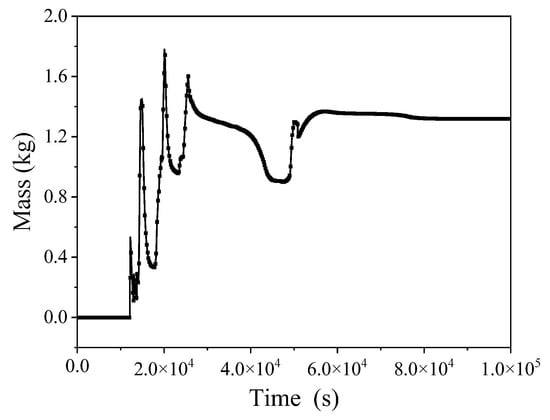
Figure 4.
Release of the alkaline earths in primary circuit.
Emergency response measures such as sprinklers or sprays can reduce the diffusion of radionuclides to the different chambers after a marine reactor LOCA. A spray device is a device that causes liquid to atomize and eject atomized droplets. The release of radionuclides can be significantly reduced by opening a sprinkler or spray device. Therefore, an emergency measure to strengthen or accurately implement a spray device is proposed.
To prevent the radionuclides’ concentration distribution from diffusing into different environments in the cabin, an emergency response measure to reduce the possibility of pressure vessel leakage was proposed based on tightness and safety performance analysis results of the internal structure in the marine reactor. The final barrier to preventing the radioactive material from spreading is the containment system, which includes the containment and all measures for automatic isolation of the building in case of an accident. Therefore, reducing the leakage rate of the containment can effectively reduce the accumulation of radionuclides and increase the radiation dose rate in the chamber.
If the adsorption capacity of radionuclides on the inner surface of the containment can be improved, more radionuclides will be deposited into the containment and less into other regional environments. Thus, improving the deposition performance of radionuclides on the inner surface of the containment is also an emergency measure for reducing radionuclides’ release [22].
Due to the number of radionuclides released from the reactor and diffused rapidly in closed cabins, it is difficult to accurately calculate the concentration distribution of radionuclides. Thus, it is necessary to conduct model calculations and real-time monitoring using emergency monitoring devices. A reasonable arrangement of radiation detection sites can help grasp the release and migration of radionuclides, essential for control and emergency rescues during nuclear accidents. Considering the secondary indices for emergency response measures, which involve monitoring the diffusion of radionuclides in closed environments, we propose five specific evaluation indices for emergency response measures in this study. The concentration distribution and diffusion range of radionuclides must be accurately analyzed to minimize the potentially harmful effects of radionuclides on workers. Therefore, an emergency response measure for improving the detection capability was proposed by increasing the number of detectors and improving detection accuracy.
Based on the results shown in Figure 2, the effective dose to which personnel were exposed exceeded the 500 mSv limit after 60 s of the LOCA. Therefore, emergency response measures, such as keeping the chambers closed and preventing spreading to the cabin, are proposed after the marine reactor LOCA. An emergency response measure that activates the emergency exhaust system of the reactor’s cabin is proposed to reduce the level of radioactivity.
Figure 5 and Figure 6 show the diffuse time for radionuclides in different chambers under various ventilation speeds and radionuclide leakage speeds, respectively. As shown in the figures, an appropriate reduction in the ventilation speed may help achieve effective emergency evacuation of staff. Furthermore, a suitable decrease in the leakage rate of the radionuclides may increase evacuation time in the chambers, thereby reducing radiation damage to staff. Therefore, two indices for emergency response measures were established: appropriate reductions in both ventilation speed and the radionuclide leakage rate.
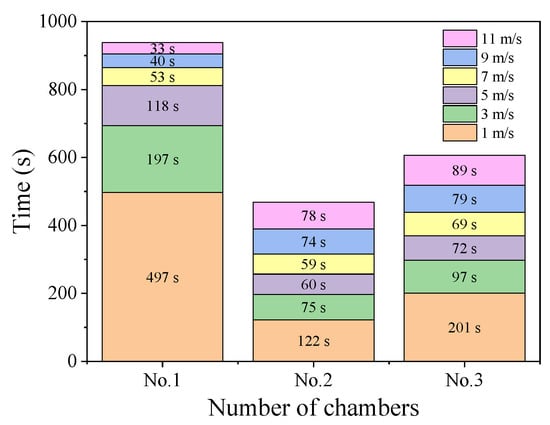
Figure 5.
Time variation of radionuclide diffusion to different chambers at different ventilation speeds.
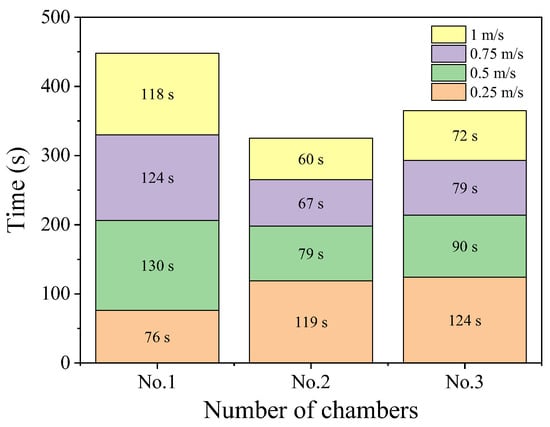
Figure 6.
Time variation of radionuclide diffusion to different chambers at different leakage speeds.
Regarding radiation protection, five indicators of emergency response measures are proposed: (1) improve the diagnostic efficiency for radiation damage, (2) control the distance from the radiation source, (3) reduce the exposure time of staff, (4) timely concealment, and (5) take stable iodine tablets.
4.2. Establishment of an Index System for Emergency Response Measures
Figure 7 shows the established index system for emergency response measures based on radiation consequences. The index system for the emergency decision-making scheme for a marine reactor LOCA had three target layers with 15 indices. The AHP was used to conduct the indices’ weight analysis for the emergency decision-making scheme owing to the requirement for a comprehensive evaluation of multiple layers.
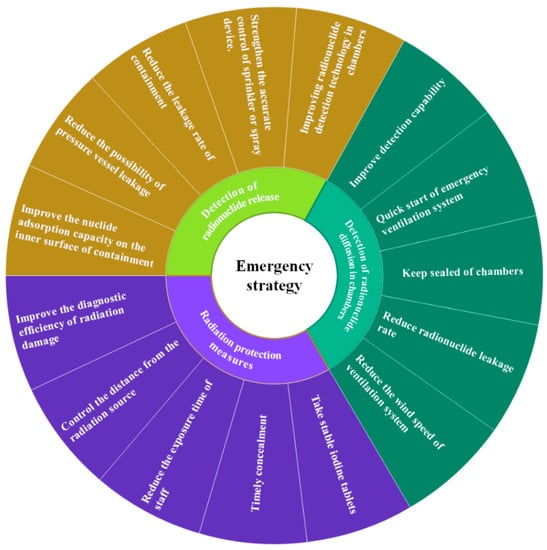
Figure 7.
Index system of emergency response measures based on radiation consequences.
The pairwise discriminant matrix of the secondary indices for the emergency measures was obtained based on the questionnaire results using the expert consultation method, as shown in Table 1.

Table 1.
Discriminant matrix of second-level indexes.
The maximum eigenvalue of the judgment matrix was , and the calculation of consistency index CI in the consistency test can be expressed as
The mean random consistency index was 0.58. The calculation process for the random consistency ratio (CR) can be expressed as
Since CR was <0.1, the judgment matrix should be considered reasonable. Therefore, the weight of the secondary index for the emergency response measures based on radiation consequences was calculated, as shown in Figure 8.
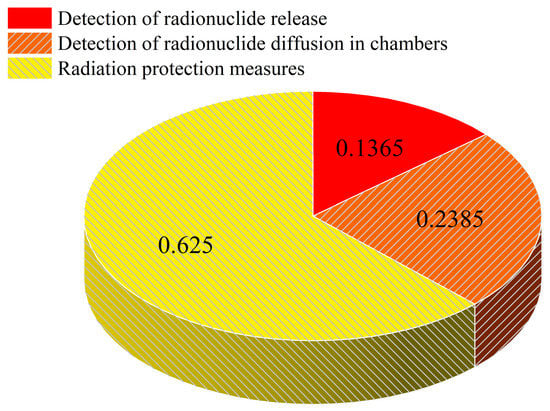
Figure 8.
Weight of the secondary indicators.
As shown in Figure 9, the index of the radiation protection measures had the maximum weight, followed by the monitoring of radionuclide diffusion in closed environments. Figure 9 shows the weights of the third-level indices established under the corresponding second-level indices.
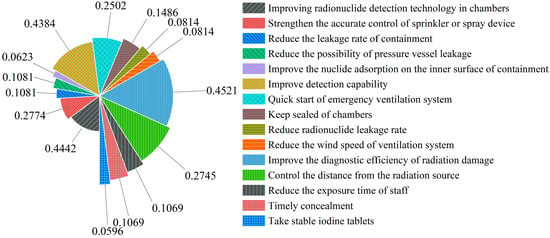
Figure 9.
Weight of the third indicators overall evaluation for emergency response measures.
In our comprehensive evaluation of emergency response measures based on radiation consequences, we used five grade evaluations for each indicator, namely V = [V1, V2, V3, V4, V5] = [Excellent, Good, General, Poor, Bad], and the assigned value was V = [20, 40, 60, 80, 100]. Thirty people with professional and scientific research experience graded each indicator in the indicator layer. Based on the indices’ fuzziness, the index’s membership degree was obtained by integrating the scores of each person on the index, and a single-factor fuzzy comprehensive evaluation matrix was established. The fuzzy membership matrix of third-level and second-level indicators for emergency measures based on radiation consequences is shown in Table 2 and Table 3, respectively.

Table 2.
Fuzzy membership matrix of third-level indicators for emergency measures based on radiation consequences.

Table 3.
Fuzzy membership matrix of secondary indexes of emergency measures based on radiation consequences.
The evaluation vectors of emergency measures for a marine reactor LOCA are as follows:
The global evaluation vector is as follows:
The overall score value is as follows:
The overall score was 82.8166, indicating that the evaluation result was adequate. This shows that the emergency measures for a marine reactor LOCA based on radiation consequences are feasible and reasonable.
5. Conclusions
In this study, emergency response measures for a marine reactor LOCA were established based on radiation consequences and analyzed comprehensively. The following three conclusions were obtained:
(1) Accident consequences are important for designing emergency response measure indices. Based on the consequence analysis model elements for a marine reactor LOCA, indicators for emergency response measures were determined based on three aspects: the monitoring of the source term released, the monitoring of radionuclide diffusion in closed environments, and radiation protection measures. The weight of radiation protection measures was 0.625, accounting for the maximum proportion. Therefore, protecting the staff and the ecological environment after the marine reactor LOCA is the primary purpose of these measures.
(2) The tertiary indicators for emergency response measures were formulated to reduce the exposure dose to staff and prolong the principle emergency operation time. AHP was used to determine the weights of all the indicators. In the emergency response measures for the monitoring of the source term released, the weight of improving radionuclide detection technology in the chambers was the highest, and the value was equal to 0.4442. By calculating the emergency response measures for the monitoring of radionuclide diffusion in a closed environment, the weight of improving detection capability was 0.4382, accounting for the maximum proportion. We calculated the emergency response measures in radiation protection measures. The weight of improving the diagnosis efficiency of radiation damage was 0.4524, accounting for the maximum proportion. Therefore, the three proposed strategies are the most important among the tertiary emergency response measure indicators. It is important to analyze and implement these three emergency measures to reduce the radiation consequences of nuclear accidents.
(3) A fuzzy comprehensive evaluation method was used to evaluate the emergency response measures for a marine reactor LOCA. The evaluation result for the nuclear emergency measures was 82.8 points, which was a suitable evaluation result. Therefore, the nuclear accident emergency response measures we established based on radiation consequences are feasible and reasonable.
In this paper, nuclear emergency response measures are established based on the radiation consequences of a marine reactor LOCA. In further research, different marine reactor severe accident models should be established to analyze radiation consequences. Sound and reasonable emergency strategies for severe marine reactor accidents will be developed to guarantee the safe operation of offshore nuclear power.
Moreover, an effective warning and monitoring system should be designed through a variety of intelligent algorithms or other advanced technologies to give full play to the role of detecting radiation consequences after a severe accident in a nuclear reactor.
Author Contributions
Y.Z. and S.X. conceptualized the research and performed the validation. Y.Z. and F.Z. administered the project, developed the methodology, curated the data, conducted the formal analysis, produced visualizations, and wrote and prepared the original draft manuscript. S.Z. and S.X. reviewed and edited the manuscript. S.Z. acquired funding. All authors have read and agreed to the published version of the manuscript.
Funding
This research was funded by the National Natural Science Foundation of China (11905102).
Institutional Review Board Statement
Not applicable.
Informed Consent Statement
Not applicable.
Data Availability Statement
The data presented in this study are available on request from the corresponding author. The data are not publicly available due to further research.
Acknowledgments
We thank all the interviewees who participated in the field visits.
Conflicts of Interest
The authors declare no conflict of interest.
Abbreviations
| LOCA | Loss of coolant accident |
| PWR | Pressurized water reactor |
| AHP | Analytic hierarchy process |
| SBO | Station black-out |
| ECCS | Emergency core cooling system |
References
- Tao, Z.T.; Fu, M.; Liu, Y.; Gao, Y.J.; Tong, H.; Hu, W.J.; Lei, L.B.; Bi, L. High-performing Proton-conducting Solid Oxide Fuel Cells with Triple-conducting Cathode of Pr0.5Ba0.5 (Co0.7Fe0.3) O3-δ Tailored with W. Int. J. Hydrog. Energy 2022, 47, 1947–1953. [Google Scholar] [CrossRef]
- Wu, G.H.; Tong, J.J.; Zhang, L.G.; Yuan, D.P.; Xiao, Y.Q. Research on Rapid Source Term Estimation in Nuclear Accident Emergency Decision for Pressurized Water Reactor Based on Bayesian Network. Nucl. Eng. Technol. 2021, 53, 2534–2546. [Google Scholar] [CrossRef]
- Lu, C.; Zhang, D.; Xian, L. Review of Reactor Accidents of Foreign Nuclear Power Submarine. Nucl. Sci. Eng. 2017, 37, 442–449. [Google Scholar]
- Xu, S.; Qin, Z.; Han, Y.; Dong, H.; Huang, Y.; Zhao, F.; Zou, Y.; Liu, Y.; Gong, D.; Xu, L.; et al. Ultrawide-range Radiation Detection Based on Dynamic Identification and Analysis of the Response of a Monolithic Active Pixel Sensor. Opt. Express 2022, 30, 14134–14145. [Google Scholar]
- Lyu, X.; Liu, S.; Ji, K.; Feng, Y.; Wang, S.; Huang, Z. Research on Hydrogen Risk and Hydrogen Control System in Marine Nuclear Reactor. Ann. Nucl. Energy 2020, 141, 107373. [Google Scholar] [CrossRef]
- Ouyang, K.; Chen, W.; He, Z. Analysis of the Radioactive Atmospheric Dispersion Induced By Ship Nuclear Power Plant Severe Accident. Ann. Nucl. Energy 2019, 127, 395–399. [Google Scholar] [CrossRef]
- Zhao, F.; Zou, S.; Liu, Z.; Xu, T.; Xu, S.; Huang, Y.; Feng, J. Study on Release and Migration of Radionuclides Under the Small Break Loss of Coolant Accident in a Marine Reactor. Sci. Technol. Nucl. Install. 2021, 2021, 6635950. [Google Scholar]
- Humphries, L.L.; Figueroa, V.G.; Young, M.F.; Louie, D.; Reynolds, J.T. MELCOR Computer Code Manuals Volume 1: Primer and Users’ Guide. Available online: https://www.osti.gov/biblio/1433069/ (accessed on 9 September 2022).
- Zhao, F.; Zou, S.; Xu, S.; Xu, T.; Liu, Z.; Huang, Y.; Feng, J. Effect analysis of break size on source term release and radioactive consequences of marine nuclear reactor during loss of coolant accident. Int. J. Energy Res. 2022, 1–15. [Google Scholar] [CrossRef]
- Zhao, F.; Zou, S.; Xu, S.; Wang, X.; Wang, J.; Tang, D. A Novel Approach for Radionuclide Diffusion in the Enclosed Environment of a Marine Nuclear Reactor During a Severe Accident. Nucl. Sci. Tech. 2022, 33, 19. [Google Scholar] [CrossRef]
- Zhao, F.; Zou, S.; Xu, S.; Wang, J.; Tang, D. Safety analysis of marine nuclear reactor in severe accident with dynamic fault trees based on cut sequence method. Nucl. Eng. Technol. 2022, 1–11. [Google Scholar] [CrossRef]
- Nath, P.D.; Rahman, K.M.; Al Bari, M.A. Thermal Hydraulic Analysis of a Nuclear Reactor due to Loss of Coolant Accident with and without Emergency Core Cooling System. J. Eng. Adv. 2020, 1, 53–60. [Google Scholar] [CrossRef]
- Zubair, M.; Suwaidi, R.; Souqi, A. Behavior of Emergency Core Cooling System (ECCS) during the early stage of Loss of Coolant Accident (LOCA) for APR 1400 with Flownex software. Prog. Nucl. Energy 2021, 141, 103949. [Google Scholar] [CrossRef]
- Greco, S.; Ishizaka, A.; Tasiou, M.; Torrisi, G. On the Methodological Framework of Composite Indices: A Review of the Issues of Weighting, Aggregation, and Robustness. Soc. Indic. Res. 2019, 141, 61–94. [Google Scholar] [CrossRef]
- Maggino, F. Developing Indicators and Managing the Complexity (Chapter 4); Springer International Publishing: Cham, Switzerland, 2017; pp. 87–114. [Google Scholar]
- Ashley, S.; Vaughan, G.; Nuttall, W.; Thomas, P. Considerations in Relation to Off-site Emergency Procedures and Response for Nuclear Accidents. Process Saf. Environ. Prot. 2017, 112, 77–95. [Google Scholar] [CrossRef]
- Park, S.; Ahn, K. Evaluation of an Accident Management Strategy of Emergency Water Injection Using Fire Engines in a Typical Pressurized Water Reactor. Nucl. Eng. Technol. 2015, 47, 719–728. [Google Scholar] [CrossRef]
- Díaz, H.; Teixeira, A.; Guedes, C. Application of Monte Carlo and Fuzzy Analytic Hierarchy Processes for Ranking Floating Wind Farm Locations. Ocean. Eng. 2022, 245, 110453. [Google Scholar] [CrossRef]
- Redfoot, E.K.; Verner, K.M.; Borrelli, R.A. Applying Analytic Hierarchy Process to Industrial Process Design in a Nuclear Renewable Hybrid Energy System. Prog. Nucl. Energy 2022, 145, 104083. [Google Scholar] [CrossRef]
- Zhao, F.; Zou, S.; Xu, S.; Xu, T. Study on Nuclide Diffusion in Closed Environment of Marine Reactor with Large Break Loss of Coolant. Nucl. Power Eng. 2022, 43, 194–198. [Google Scholar]
- Mohamed, A.; Omar, A.; Ababneh, A.; Omar, A.; Mohamed, A. Gamma spectroscopy for the investigation of radiation contamination in the UAE. Int. J. Nucl. Energy Sci. Technol. 2020, 14, 141. [Google Scholar] [CrossRef]
- Zhang, T.; Yu, M.; Song, M.; Feng, W. Characteristics of Thermophoresis Deposition of Aerosols in the Containment. Nucl. Saf. 2018, 17, 36–39. [Google Scholar]
Publisher’s Note: MDPI stays neutral with regard to jurisdictional claims in published maps and institutional affiliations. |
© 2022 by the authors. Licensee MDPI, Basel, Switzerland. This article is an open access article distributed under the terms and conditions of the Creative Commons Attribution (CC BY) license (https://creativecommons.org/licenses/by/4.0/).